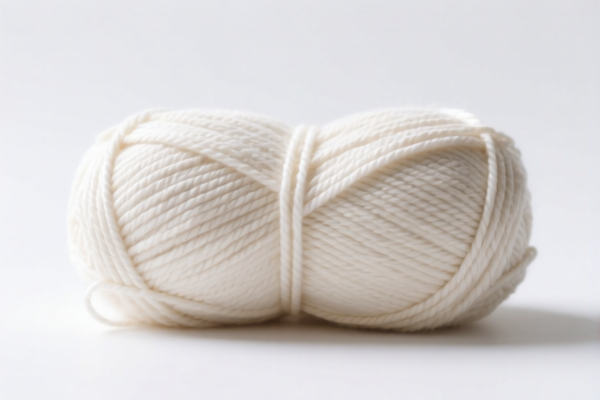| HS Code | Official Doc | Tariff Rate | Origin | Destination | Effective Date |
|---|---|---|---|---|---|
| 5401100000 | Doc | 66.4% | CN | US | 2025-05-12 |
| 5401200000 | Doc | 66.4% | CN | US | 2025-05-12 |
| 5406001090 | Doc | 62.5% | CN | US | 2025-05-12 |
| 5406001090 | Doc | 62.5% | CN | US | 2025-05-12 |
| 5509910000 | Doc | 67.0% | CN | US | 2025-05-12 |
| 5509920000 | Doc | 62.5% | CN | US | 2025-05-12 |
| 5511300000 | Doc | 62.5% | CN | US | 2025-05-12 |
| 5511100030 | Doc | 62.5% | CN | US | 2025-05-12 |
| 1102906000 | Doc | 64.0% | CN | US | 2025-05-12 |




Woolen Yarn
Woolen yarn is a textile fiber obtained from sheep and other animals, characterized by its crimped, soft, and insulating properties. It is a staple fiber, meaning it is composed of individual units (fibers) that have a finite length.
Material
The primary source of woolen yarn is the fleece of sheep. Different breeds of sheep produce wool with varying characteristics, influencing the yarn's quality and suitability for specific applications. Other animals providing wool include:
- Alpaca: Produces a soft, luxurious fiber with excellent drape.
- Cashmere: Known for its exceptional softness and warmth, derived from cashmere goats.
- Mohair: Obtained from Angora goats, resulting in a silky, lustrous fiber.
- Angora: From Angora rabbits, yielding a very soft, fluffy yarn.
Purpose
Woolen yarn is primarily used for:
- Knitting: Creating garments, accessories, and home décor items.
- Crocheting: Similar applications to knitting, utilizing a different stitch technique.
- Weaving: Producing fabrics for clothing, upholstery, and rugs.
- Felting: Matting, condensing, and interlocking fibers to create dense materials.
- Crafting: Various decorative and functional projects.
Function
The key functions of woolen yarn stem from its inherent properties:
- Insulation: The crimped structure traps air, providing excellent thermal insulation.
- Moisture Absorption: Wool can absorb a significant amount of moisture without feeling wet, contributing to comfort.
- Durability: Wool fibers are naturally resilient and resistant to wear.
- Breathability: Allows air circulation, preventing overheating.
- Flame Resistance: Naturally flame-resistant, offering a degree of safety.
Usage Scenarios
- Winter Clothing: Sweaters, hats, scarves, gloves, socks.
- Blankets and Throws: Providing warmth and comfort.
- Upholstery: Durable and aesthetically pleasing fabric for furniture.
- Rugs and Carpets: Providing insulation and sound absorption.
- Baby Clothes: Softness and warmth make it suitable for infants.
Common Types
Woolen yarn is categorized based on several factors:
- Fiber Diameter (Micron Count):
- Fine Wool: (18-24 microns) - Soft, luxurious, used for delicate garments. (e.g., Merino)
- Medium Wool: (25-32 microns) - Versatile, suitable for a wide range of projects.
- Coarse Wool: (33+ microns) - Durable, used for outerwear and rugs.
- Spinning Method:
- Worsted Yarn: Smooth, strong, defined stitch definition.
- Woolen Yarn (carded): Fluffy, softer, less defined stitch definition.
- Ply: Refers to the number of strands twisted together. More plies generally create a stronger, more durable yarn. (e.g., Single Ply, 2-Ply, 4-Ply)
- Weight: Refers to the thickness of the yarn. (e.g., Fingering, Sport, DK, Worsted, Bulky, Super Bulky)
- Treatment/Dyeing:
- Natural Wool: Undyed, retaining the natural color of the sheep's fleece.
- Dyed Wool: Colored using various dyes.
- Superwash Wool: Treated to prevent felting and shrinkage.
Woolen yarn, typically used in knitting, weaving, and crocheting for garments, blankets, and other textile products, falls under several potential classifications depending on its composition and whether it's put up for retail sale.
Here are the relevant HS codes based on the provided reference material:
-
5509910000: Yarn (other than sewing thread) of synthetic staple fibers, not put up for retail sale: Other yarn: Mixed mainly or solely with wool or fine animal hair (607). This code applies to yarn not for retail sale, primarily composed of synthetic staple fibers blended with wool.
- Chapter 55: Cotton, wool, or other textile fibers.
- Heading 5509: Yarn (other than sewing thread) of synthetic staple fibers.
- Subheading 5509.91: Other yarn, mixed mainly or solely with wool or fine animal hair.
-
5509920000: Yarn (other than sewing thread) of synthetic staple fibers, not put up for retail sale: Other yarn: Mixed mainly or solely with cotton (607). This code applies to yarn not for retail sale, primarily composed of synthetic staple fibers blended with cotton.
- Chapter 55: Cotton, wool, or other textile fibers.
- Heading 5509: Yarn (other than sewing thread) of synthetic staple fibers.
- Subheading 5509.92: Other yarn, mixed mainly or solely with cotton.
According to the provided reference material, the HS code options related to 'woolen yarn' are limited, with only the following 2 found.
Please note that these codes specifically refer to yarn not put up for retail sale. If the woolen yarn is packaged for retail sale, these codes would not be applicable based on the provided information.
Customer Reviews
No reviews yet.